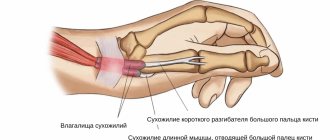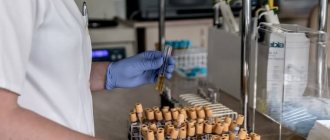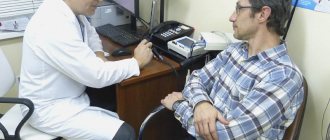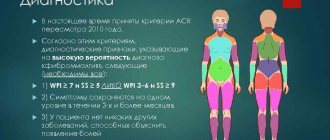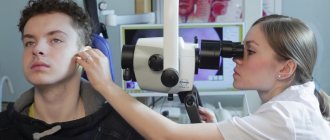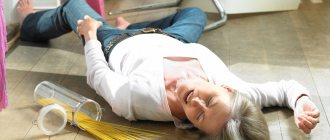The disease does not last long, but exacerbations (relapses) occur quite often.
There are two types of disease:
- de Quervain's thyroiditis - occurs after a viral infection;
- lymphocytic - antibodies to thyroid tissue can be detected; it often occurs in women after childbirth, and then this thyroiditis is called postpartum thyroiditis.
The focus of inflammatory changes in the gland is usually small and does not occupy the entire lobe. Under the influence of inflammatory processes, thyroid follicles can be damaged or ruptured. As a result, a large amount of thyroid hormones is released.
Subacute thyroiditis. Symptoms
The symptoms of the pathology are vague and can be confused with other diseases of the endocrine system.
Often at first there is general weakness and loss of strength. If this condition begins immediately after a viral infection, then you might think that it has started again. At this stage, you can pay attention to such manifestations as:
- in the evening the temperature rises to 37-38 degrees;
- there is a lump in the throat or other discomfort in the neck;
- When you try to touch your neck, you feel pain in its lower part, most often it radiates to the jaw and the area behind the ears.
Causes
The likely cause of thyroiditis is a viral infection. All patients have a history of influenza, adenoviral infection, measles, and also have a high level of antibodies to the Coxsackie virus , picoviruses , and cytomegalovirus . There are also cases of subacute thyroiditis with systemic scleroderma .
If we consider de Quervain's disease, the causes of the disease are as follows:
- heavy load on the hand, performing repetitive movements (knitting, typing on the keyboard, playing the piano);
- hand injuries (dislocations, sprains);
- hormonal changes;
- inflammatory processes in the joints, in which periarticular tissues are secondarily involved.
Among the risk factors are female gender, sports (especially tennis and badminton), age over 50 years, as well as professions associated with stress on the hand (painter, mechanic, milkmaid, stonemason).
Diagnostics
To diagnose and identify the disease, you need to consult an endocrinologist. The specialist will conduct an examination, study the patient’s clinical picture, and perform palpation.
Usually, in the presence of chronic autoimmune thyroiditis of the thyroid gland, the doctor can feel local compactions, which are extremely painful for the patient.
To make a final diagnosis and obtain a more complete picture, an ultrasound of the thyroid gland and a blood test are prescribed. If there is pathology, an ultrasound will reveal a focus or foci of inflammation, and a laboratory blood test will show a high level of ESR and CRP. Often, elevated levels of thyroid hormones (thyroid hormones) in the blood are also detected.
Four stages of De Quervain's thyroiditis
- Initial stage (acute, thyrotoxic). Lasts 3-6 weeks. It is characterized by clinical manifestations, which we reviewed earlier. According to the hormonal test, a high level of free T3 and T4 is noted against the background of a reduced level of TSH.
- Euthyroid stage. Lasts 1-3 weeks. Destroyed follicles stop producing thyroid hormones.
- Hypothyroid stage. Lasts from 2 to 6 months. Transient hypothyroidism appears.
- Recovery. Normalization of the thyroid structure and restoration of previously lost gland function.
Subacute thyroiditis. Treatment
After a thorough diagnosis, the patient will be prescribed treatment. Typically, treatment consists of taking special medications, and if you follow all the specialist’s recommendations, complete recovery is achieved. The average duration of treatment is one to two months; during this period, a person’s condition can be completely restored, and strength and energy can return to them.
Self-medication of subacute thyroiditis of any kind is very dangerous, as this can lead not only to prolongation of the disease, but also to serious consequences for the entire body, because subacute thyroiditis is a disease that has not been fully studied and there can be no room for error.
Endocrinologist Romanov G.N.
I, Romanov Georgy Nikitich, endocrinologist, associate professor, candidate of medical sciences. For over 20 years I have been helping people get rid of or alleviate thyroid disease. During my work, I have had many patients with subacute thyroiditis, so I well understand the specifics of treating this disease.
For 20 years, I had the opportunity to work both in public medical institutions as an ordinary doctor and head of department, and as a consultant to patients in private medical centers. Today it is possible to get my consultation online. To sign up for a paid consultation, write to me in any of the instant messengers or my personal social media. network: Viber, Telegram, Instagram, WhatsApp, Skype, Vkontakte.
Answers to popular questions about subacute thyroiditis
In addition to seeing patients in the medical center and online, I answer small questions on the forum. I would like to give an example of the most popular questions from there.
Alesya: Diagnosis of subacute thyroiditis. She was treated with Medrol from August 2013 to April 2014. I took the last dose of 2 mg 2 weeks ago, the tests were normal. I went on vacation, now on the 5th day I started having pain in the neck, which gets worse at night, I have no way to contact the doctor, I will get an appointment in five days. I took 8 mg of Medrol on my own, the pain subsided, but did not completely go away. What to do next: take medrol in what dosage? Or you can leave a one-time dose of 8 mg, i.e. no longer accept?
Romanov G.N: The insidiousness of subacute is that it recurs VERY OFTEN. For each relapse, you need to start treatment as for the first time: 4 tablets of Medrol, 4 mg each in the morning and 2 tablets in the afternoon. And then a SLOW reduction to ½ and even ¼ tablet.
Shnatalya: Good afternoon! Please tell me if there have been cases in your practice when subacute recurrence occurred 4 times. Cancellation of prednisolone with a reduction according to the scheme leads to exacerbation again. If such treatment is ineffective, should I remove it or something, just inflamed, without nodes? Now my doctor has prescribed me Medrol again at a dose of 32 mg. He said that I would take this dose for a long time. I am so afraid of the consequences of taking this drug. And there is no way out. Please tell me something. How can I defeat him (PT0) this fourth time?
Romanov G.N: I had a relapse 3 times. Is it actually subacute? High ESR and high CRP? Subacute is generally an interesting disease - some authors believe that it can not be treated at all, although this is not correct.
Tatyana: I'm 31 years old. 2.5 months after the second birth, headaches began, tachycardia and slightly increased blood pressure, throwing me into a fever in the morning (lasted about 2 weeks). Everything is fine now. In childhood (I took AIT, l-thyroxine). Everything also went away and the diagnosis was removed while still at school, I periodically took tests, everything was fine. During pregnancy, all tests are normal.
T4 free - 1.99
Free T4 in terms of pmol/l -25.62
TSH - less than 0.005
Antibodies to TSH receptors - less than 0.300
Could this be postpartum thyroiditis, and the TSH will return to normal? My endocrinologist told me to stop guarding and start taking pills; I don’t plan to stop guarding my child for three months.
Romanov G.N: Very similar to postpartum. Wait a couple of weeks - if the postpartum picture with hormones changes quickly.
Marina: Good afternoon! I am diagnosed with subacute recurrent thyroiditis. I have been undergoing treatment with prednisone for 1.5 years, the hormone has many side effects, I want to undergo surgery. Please tell me where is the best place to have the operation?
Romanov G.N: In our country, subacute thyroiditis is not operated on. You just need to choose the individual correct treatment regimen.
Olya: Good afternoon! She treated subacute thyroiditis with prednisolone with 20 mg for 2 weeks and reduced it by 5 mg every week, bringing it to 1/4, the tests were all normal two weeks before the cancellation, she took them, the day before the cancellation she did an ultrasound, the residual effects of subacute thyroiditis showed, but after the cancellation a couple of days later a relapse began (the temperature was 37 again, pain when palpating, pain when swallowing, radiating to the back of the head.) The doctor prescribed prednisolone again, but a smaller dose of 10 mg, reduce it after a week, in principle I feel good on this dose. I’m already afraid that after the withdrawal there will be a relapse again, is it because I didn’t complete the treatment? How long to take a dose of 10 mg so that a relapse does not start again. I have phlegm in my throat, despite being treated with POLIDEX spray, there may be a relapse because of this, i.e. What kind of bacteria is in your nose? I would be grateful for your feedback!
Romanov G.N: Relapses are very typical for subacute cases. Reduce the dose even more slowly.
Autoimmune thyroiditis. "The Mystery of the Century." Part 1.
Murzaeva Irina Yurievna
Endocrinologist, Preventive Medicine Doctor
July 12, 2021
Autoimmune thyroiditis has become a mystery not only of the 20th, but now of the 21st century. The reasons that cause it have not yet been solved; there are many theories, but there are no final answers. Although the theory of environmental pollution is more likely!, that’s not what we’re talking about today. There has been some confusion regarding this diagnosis; it is given to everyone who needs it and who doesn’t, and is often treated quite frivolously.
But this is a serious autoimmune inflammatory process in the thyroid gland, which is not subject to any predictions, its course is impossible ! A sharp turn in the course of AIT can occur at any time. Today I will tell you something about it that you have never read, the source of information is very reliable, clinical observations of the disease began in the late 60s of the 20th century.
So,
- AIT does not always debut with a chronic process; it can begin acutely and have a picture completely similar to that of subacute thyroiditis; treatment in this case will be similar. Or another option is possible: during sluggish AIT, an acute period may occur and it will also be completely similar to subacute thyroiditis. The only thing that can distinguish AIT from subacute thyroiditis is the density of the thyroid gland, which can reach the characteristics characteristic of Riedel’s goiter (the thyroid gland in AIT is often very dense, which does not happen with subacute thyroiditis), that is, the density of the thyroid tissue can reach (+++ +). Yes, there is such a classification of thyroid density (0/ +/ ++/ +++/ ++++). Moreover, it is interesting that in previous years it was customary to treat the acute course of AIT with goiter with a combination of Prednisolone and T3 (in doses of at least 25 mcg) , without T4, because, as a rule, acute AIT is accompanied by severe goiter (a sharp increase in the thyroid gland), which responds well treatment with T3 (which is an active hormone, not a prohormone like T4).
- AIT has become often combined with DTZ (diffuse toxic goiter), moreover, DTZ against the background of AIT flows more easily and remission can occur faster than without AIT. DTZ goes into AIT easily, but the transition of AIT into DTZ is extremely rare. Although I have had such patients, and in one of them the transition from AIT to DTG occurred in the 3rd trimester of pregnancy, which was previously considered completely incredible. I'm talking about the unpredictability of the course of AIT.
- AIT occurs more easily in iodine-deficient regions of Russia, but in regions with normal iodine content, it can worsen its course. And therefore, Russian comrades :) who moved for permanent residence to Italy, Spain, the USA and other hot countries need to be on their guard, many have already brought from there a sharply developed AIT with dysfunction, hypothyroidism and a high level of TSH.
- A low titer of antibodies in AIT is not a “good process”: cry:, it’s just a different type of immune reaction: high antibodies in AIT are a humoral type of immunity, and a low titer is cellular, it is not yet known which is better. With the humoral type, patients respond more easily to iodine and drugs with it (it is better tolerated) than with the cellular type; with the humoral type, anti-hepatitis drugs, vaccines and other immune stimulants are “not good”.
- If you are “lucky” and the immune reactions during AIT are not uncontrolled, then AIT will have a latent course with preserved thyroid function and lifelong use of L-thyroxine preparations will not be required.
- When compensating for hypothyroidism against the background of AIT, given the absence of T3 in pharmacies, T4-euthyroidism can be easily achieved, but T3-euthyroidism is not, why, with T4 monotherapy, signs of hypothyroidism may persist (this may be a consequence of uncompensated T3-hypothyroidism), here it is fashionable to draw an analogy with the concept of T4 - / T3 thyrotoxicosis. T3 thyrotoxicosis is more difficult and slower to treat.
- Quite sad news: the younger AIT 18+ began, the more severe it will be (this does not apply to children, they have their own characteristics, only adults), although there are exceptions to this rule - I had patients who, after a long the course of AIT went into spontaneous remission and went away even with large doses of HRT with 100 mcg of L-thyroxine - in 0 mcg! I warned you - the course of AIT cannot be predicted!!
- Taking into account the above information, it should be noted: the treatment of AIT should only be carried out by an endocrinologist, not a gynecologist, not a general practitioner - this is a disease with great “nuances and details”!
- AIT can indeed provoke the development of hypertension, and its treatment (AIT) can improve the course of hypertension or stop it completely.
- AIT can be combined with any thyroid disease: cancer, nodular nontoxic and toxic goiter, etc. How these diseases in combination affect each other has not yet been studied.
- Already in the 80s of the 20th century, L-thyroxine intolerance in patients with AIT was mentioned in the scientific literature , which, unfortunately, is not recognized by many doctors, and even endocrinologists. But in fact, there is a small percentage of people who have developed intolerance to L-thyroxine preparations or intolerance to L-thyroxine in doses above 25 mcg. I observed at least 10 people with such a reaction, the most striking example was a 70-year-old man (Novgorod region), after surgery for retinoblastoma of the orbit (this is a complex tumor process of the eye tissue), he developed hypothyroidism with a TSH of 40 mIU/ml and an attempt to prescribe him thyroid hormone drugs - his blood pressure dropped sharply, dizziness and nausea began, he could not get up, when he missed taking L-thyroxine, he felt better and a decision was made not to continue the treatment , and was interpreted as an abnormal reaction to L-thyroxine. thyroxine, increased TSH - was interpreted as a “compensation reaction”, since with hypothyroidism metabolic processes in the body slow down - therefore, tumor metastases will develop and progress more slowly!!!
- Nodes (colloid) accompanying AIT are not always a pseudonodular (false nodular) form of AIT (AIT is often characterized by false nodes - that is, not a “tissue growth”, but an inflammatory process - lymphoid infiltration without the “tissue plus” . These the nodes can be either a nodular goiter or a toxic adenoma and cancer, parathyroma (formation of the parathyroid glands), and even lymphoma and any other process, therefore, in many cases, a biopsy of thyroid formations is indicated!!!!! Biopsy and cytological conclusion is a specific research method with AIT and almost the main one in diagnosing AIT!!, while all other methods - ultrasound, hormones (blood), scintigraphy, iodine uptake curve - are nonspecific methods and make the diagnosis probable!
- There are concepts of abortive form of AIT and spontaneous remission of AIT .
 Sounds joyful The abortive form of AIT is a variant of “self-recovery” when no signs of AIT remain over time! It occurs rarely, usually 10 or more years after the start of AIT (I have seen such variants). Remission of AIT can also be spontaneous after long-term drug therapy (for example, complete cessation of taking L-thyxine, while maintaining a small titer of antibodies to the thyroid gland). Which makes this pathology even more mysterious.
Sounds joyful The abortive form of AIT is a variant of “self-recovery” when no signs of AIT remain over time! It occurs rarely, usually 10 or more years after the start of AIT (I have seen such variants). Remission of AIT can also be spontaneous after long-term drug therapy (for example, complete cessation of taking L-thyxine, while maintaining a small titer of antibodies to the thyroid gland). Which makes this pathology even more mysterious.
Conclusions: AIT can have a primary chronic course, either with an acute onset or frequent exacerbations, with or without impaired thyroid function, hypothyroidism or, less commonly, hyperthyroidism. AIT with an abortive course or remission, or with transformation into another pathology - DTZ, etc. AIT can be expressed as a hypertrophic form (a sharp increase in the thyroid gland) or an atrophic form (a sharp decrease in the thyroid gland), with an increase (humoral type of immunity) or without an increase in titer thyroid antibodies (cellular type) immunity, less often - mixed type of immunity ... against the background of either iodine deficiency or without deficiency. Yoda, now ALL THIS needs to be treated somehow... To be continued in the second part....
My Instagram - endocrinolog.murzaeva


